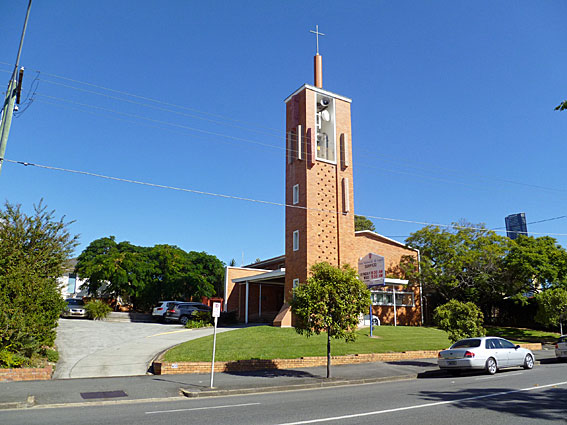
St Michael and All Angels' Anglican Church, New Farm
[Photograph by David Vann (May 2012)]

St Michael and All Angels' Anglican Church, New Farm
[Photograph by David Vann (May 2012)]
Historical and Technical Documentation by Geoffrey Cox
© OHTA 2012, 2013, 2020 (last updated January 2020)
The parish of St Michael & All Angels, New Farm, dates from the late nineteenth century. A temporary church building there was burned down in the course of construction in November 1890.1 The congregation lost no time in rebuilding, and a new church was opened in March 1891 by Bishop Webber.2 This was the 'school church' designed by J.H. Buckeridge, the Anglican Diocesan Architect for Brisbane.3
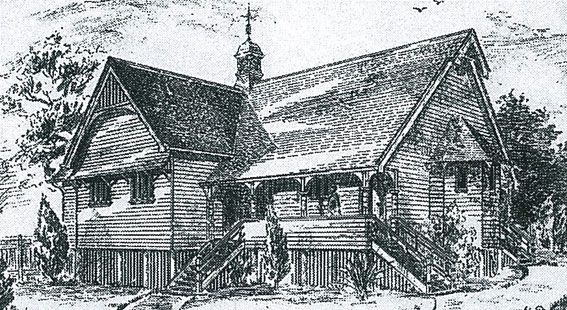
The 'school church' of St Michael and All Angels, New Farm
designed by J.H. Buckeridge
[Drawing from Building, Engineering (and Mining) Journal
of Australia and New Zealand (28 March 1891)]
Built to the design of the architects Conrad and Gargett of Brisbane, the present church was dedicated by Archbishop Halse on 22 March 1959.4 The old church became the upper hall at this time.
First Organ.
There was an organ in use here by at least May 1894, when an organ recital advertised for Friday 4 May had to be postponed until Wednesday 9 May at 8pm.5 It seems likely that this was the opening recital of a new organ, although the advertisement does not make this clear and does not give the name of the organist. In April 1897 it was recorded that Miss Norah Little had 'resumed' as organist at St Michael and All Angels.6 She was still described as organist a year later, and her father conducted the choir at this time.7
Although the old organ survived largely unaltered at New Farm until 1964, the name of the builder remained a mystery until the 1980s. Mr Joe Whitehouse always believed the instrument to have been of German origin,8 a fact that was clearly suggested by the spelling of the stop names.
The specification of the old organ can be reconstructed from other sources as follows. The five draw-stops were located in a single row above the keyboard, with the 'coupla' in the middle:
| MANUAL Geigen Principal 8 Salicional 8 Gedeckt 8 Flöte 4 PEDAL [No stop on console] COUPLER Coupla |
8 8 8 4 |
[Ten. C] [stopped bass] [12 pipes only] [= Manual to Pedal] |
Mechanical action
Draw-stop console
Compass: 54/27.9
This instrument appears to have been the first German-built organ imported into Queensland. The builder's identity finally came to light accidentally in the mid 1980s as a result of an enquiry made by Mr John Poynter of St Peter's, South Australia, to the firm of G. F. Steinmeyer, Oettingen, West Germany. This enquiry was concerning harmoniums exported by the firm to Australia. The firm's records revealed that a pipe organ was ordered in 1891 by a Mr Süss, originally from Bavaria, who appears to have been a merchant in Woollongabba, Brisbane. As the entire correspondence on his side was through his father and brother, the firm had no record of his address. They were informed, however, that the organ had eventually been set up in Wooloongabba, and was found to be satisfactory, though its eventual location was not known. The organ had cone pallet chests (Kegelladen) with mechanical action, and was listed in the Steinmeyer records as Op. 425, with the following specification:
der Orgel Opus 425
in der Kirche Jahr 1891
Woolaongabba bei Brisbone / Australien
| Manual C - f''' Liebl. Gedeckt 8' Salicional 8' Geigenprincipal 4' Flöte 4' Pedal C - d' angehängt Pedalkoppel als Zug.10 |
8' 8' 4' 4' |
These details agree closely with those of the New Farm organ. The main discrepancy between the New Farm specification and the Steinmeyer records is the existence of 12 pedal pipes, which are not mentioned in the latter. It is clear that there were pedal pipes at New Farm before 1964, and it may be significant that there was no corresponding stop-knob on the console. The stop was presumably, therefore, 'permanently on'. The word angehängt in the Steinmeyer records means 'attached' and refers to the use of pedal pulldowns, without pedal pipes, while Pedalkoppel als Zug refers to a pedal coupler that works 'by drawstop'. It is likely that the 12 pedal Bourdon pipes were added to the organ some time between 1891 and 1964, but the only references to major work on the instrument in the Whitehouse Bros ledgers from 1922 onwards is to blower repairs in 1943, 1945 and 1946, and a 'new pedal spring' in June 1944.11
The other discrepancy concerns the pitch of the Geigen Principal, although it is possible that the designation 4ft in the builder's records referred to its Tenor C compass. It is interesting that the pitch designation had been removed from the original stop-knob by the time it reached Hughenden (see below). The bottom octave of the stop formed the façade, tubed off the main soundboard.
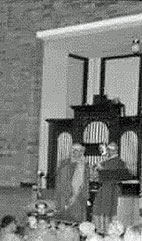
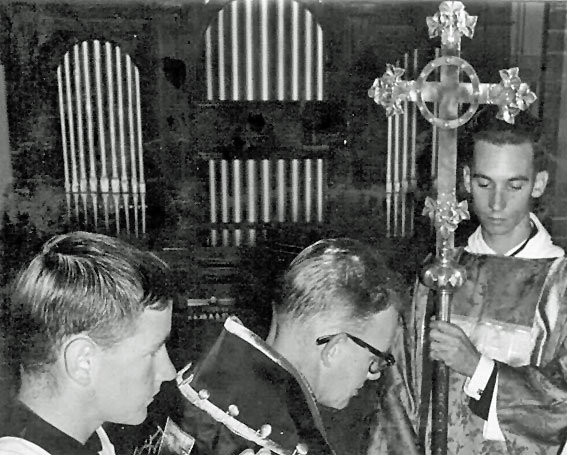
The 1891 Steinmeyer organ relocated in the new church after 1959
[Photographs from Anglican Diocese of Brisbane,
Records & Archives Centre, NEWFS, Box 13]
This instrument survived into the second half of the century, and was moved in 1959 from the old church into the new church at New Farm. In 1964, its pipework was incorporated into a new electric-action extension organ by Whitehouse Bros of Brisbane (see below). The old console, pedalboard, soundboard and action were restored and re-used by Whitehouse Bros at Sacred Heart Catholic Church, Hughenden in 1967-68, with new pipework to the original specification, but without pedal pipes. Unfortunately, it all came to a sad end when the organ was removed from Hughenden in 1981 and literally 'fell off the back of a truck' in the process!12
Present Organ.
The new Whitehouse organ of 1964 comprised seven ranks extended to provide a specification of 20 stops spread over two manuals and pedals. It was housed in a purpose-built chamber in the new church, and incorporated all of the pipework from the old organ.

The 1964 Whitehouse Bros extension organ
in a purpose-built chamber in the new church
[Photograph by David Vann (May 2012)]
In the stop-list below, ranks A, F and G were entirely new in 1964. New pipes were provided also to allow for extension and increased compass in the existing ranks as follows: 35 new pipes in B; 31 new pipes in C; 19 new pipes in D; 31 new pipes in E. The stopped bass of the original Salicional 8ft was re-used as the bottom octave of the Swell Flute (rank D), which was originally at 4ft pitch only.13
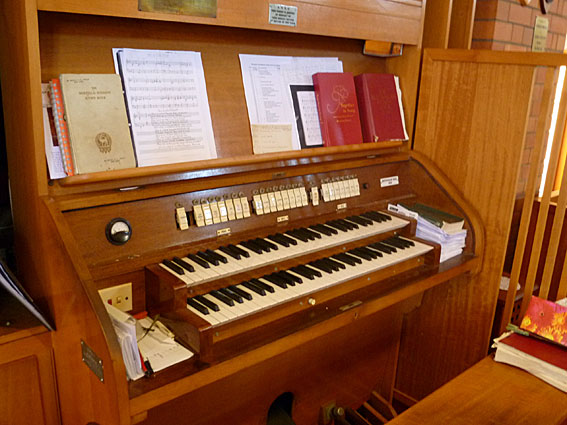

Console details of the 1964 Whitehouse Bros organ
[Photographs by David Vann (May 2012)]
| GREAT Open Diapason 8 Gedact Principal Octava Gedact Twelfth Fifteenth Tierce SWELL Diapason Flute Salicional Gemshorn Flute Salicet Piccolo Oboe PEDAL Bourdon Echo Bourdon Bass Flute Principal Oboe COUPLERS Swell to Great Great to Pedal Swell to Pedal |
8 8 4 4 2-2/3 2 1-3/5 8 8 8 4 4 4 2 8 16 16 8 4 8 |
A B A B B A B C D E C D E D F G B G A F |
[1891] [1891] [1891] [1891] [1891] |
General tremulant
Attached stop-key console
Direct electric action
Compass: 61/30
Balanced swell pedal
1 General piston (adjustable).14
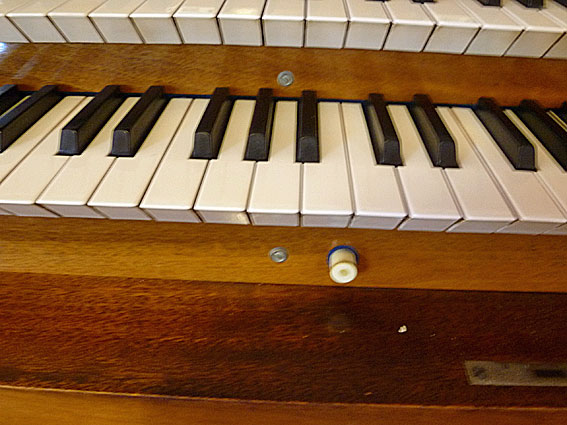
The unusual single 'general' piston, adjustable by
toggle switches above each stop-tab
[Photograph by David Vann (May 2012)]
After intruders gained access to the church and caused extensive damage to this instrument, the greater part of the pipework was reportedly replaced around the end of the year 2000 by Ian D. Brown & Associates of Ballina.15
_____________________________________________________________
1 The Brisbane Courier (26 November 1890), p. 5; 'Diary of Events' for 26 November 1890 in Pugh's Queensland Almanac . . . for 1891.
2 The Brisbane Courier (20 March 1891), p. 5; 'Diary of Events' for 19 March 1891 in Pugh's Queensland Almanac . . . for 1892.
3 Donald Watson & Judith McKay, Queensland Architects of the 19th Century: A Biographical Dictionary (Brisbane: Queensland Museum, 1994), pp. 25-26.
4 Brisbane City Council Heritage Unit, Heritage Citation, St Michael's and All Angels Church, New Farm (April 2003).
5 The Brisbane Courier (4 May 1894), p. 2; The Brisbane Courier (9 May 1894), p. 2.
6 The Brisbane Courier (12 April 1897), p. 5.
7 The Brisbane Courier (15 April 1898), p. 5.
8 Personal communication to G. Cox from Mr J.H. Whitehouse, c.1973.
9 Specification reconstructed from information supplied by Kevin Whitehouse and J.H. Whitehouse (1973-74), Canon D.J.F. Williams (1973), and David Molloy (noted at Hughenden – see below - in 1971).
10 Letter dated 13 September 1984 from Paul Steinmeyer to John Poynter; communicated to G. Cox by John Maidment, and referred to in OHTA News, vol. 11, no. 1 (January 1987), p. 17.
11 Whitehouse Bros Ledger (1940-1954), p. 409.
12 Geoffrey Cox, 'The Ignoble Tale of an Organ that (literally) "Fell off the Back of a Truck",' OHTA News, vol.11, no. 2 (April 1987), pp. 16-18; rpt. in Organ Society of Queensland Newsletter, vol. 15, no. 4 (February 1988), pp. 34-37.
13 Details supplied by Kevin Whitehouse to G. Cox, c.1972, and from Service of Blessing and Dedication of the Rebuilt and Enlarged Pipe Organ (26 April 1964) – cited at Anglican Diocese of Brisbane, Records & Archives Centre, June 2012.
14 Specification noted by G. Cox, December 1972.
15 The Organ Voice, vol. 26, no. 4 (December 2000), p. 25; The Sydney Organ Journal, vol. 32, no. 1 (Summer 2001-01), p. 31.